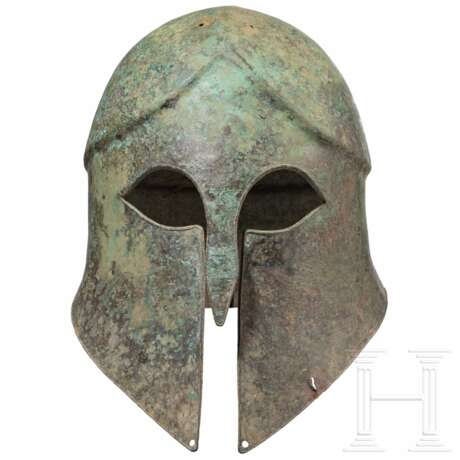Korinthischer Helm der entwickelten dritten Stufe mit Merkmalen der Lamia-Gruppe, spätes 6. - frühes 5. Jhdt. v. Chr.
10.10.2023 10:00UTC +01:00
Classic
Sold
54000EUR € 54 000
| Auctioneer | Hermann Historica |
|---|---|
| Event location | Germany, Grasbrunn / München |
| Buyer Premium | 25 % |
Archive
The auction is completed. No bids can be placed anymore.

ID 1033520
Lot 7 | Korinthischer Helm der entwickelten dritten Stufe mit Merkmalen der Lamia-Gruppe, spätes 6. - frühes 5. Jhdt. v. Chr.
Estimate value
€ 49 000
Die gesamten unteren Kanten (an Nasal, Augenausschnitten, Wangenklappen und Nackenschutz) zu einer schmalen Rippe verdickt. Ansonsten wie typisch für Vertreter dieser Helmgruppe keine Verzierungen. Die Wangenklappen durch einen stumpfwinkligen Zwickel vom Nackenschirm getrennt, der von der Wandung ausgehend im leichten Bogen nach außen schwingt.
Durchbohrungen zur Befestigung eines Helmkamms auf beiden Seiten des Scheitelknicks in der Kalotte, knapp hinter dem Stirngiebel und in der Mitte des Hinterhaupts, knapp oberhalb des Nackenschirms. Länge von den Spitzen der Wangenklappen zur Kante des Nackenschutzes ca. 28 cm. Höhe ca. 29 cm. Breite an den seitlichen Zwickeln 20 cm, maximale Breite des Nackenschutzes 20,8 cm. Einzige Beschädigung ist ein ca. 1,5 cm langer Riss in der Unterkante des linken Wangenschutzes. Ansonsten ausgezeichnet erhaltener Bronzehelm ohne Fehlstellen und Restaurationen! Dunkelgrüne, matte, leicht fleckige Patina.
Selten gut erhaltener, später korinthischer Helm mit strenger, klar strukturierter Formgebung, die gerade in ihrer Schlichtheit ohne Verzierung besonders eindrucksvoll wirkt. Helme dieser Gruppe konnten auch nach hinten geschoben getragen werden, sodass das sonst verdeckte Antlitz des Kriegers sichtbar wurde. Bildnisse der Pallas-Athene zeigen sie häufig mit einem solchermaßen auf dem Hinterhaupt getragenen Helm. Der auf zahlreichen Werken der Skulptur und Vasenmalerei dargestellte Helmtyp gilt vielfach als Inbegriff des griechischen Helmes schlechthin.
Provenienz: Aus der Sammlung eines süddeutschen Altphilologen, von diesem in den 1950er bis 1960er Jahren erworben. Dann weiter in Familienbesitz.
A Corinthian helmet of the developed third stage with features of the Lamia group, last 3rd of the 6th - early 5th century B.C.
An exceptionally beautiful and almost perfectly preserved top example of a developed Corinthian helmet. The calotte, preserved without any damage, is set off from the wall by a slightly undercut bend and provided with a shallow edge along the crest. The wall at the forehead is drawn upwards like a gable, merging into a tongue-shaped nasal at the bottom, with arched cut-outs for the eyes at the sides, ending in a spandrel at the back. From this spandrel run the inwardly curving front parts of the cheek guards, which are extended far downwards and leave only a narrow slit, which is covered in the upper half by the nasal. A hole in the lower tips of the left and right cheek guard. The entire lower edges (nasal, eye cut-outs, cheek guards and neck guard) thickened into a narrow rib. Otherwise, as is typical of representatives of this helmet group, no decoration. The neck guard, which swings outwards from the wall in a slight curve, is separated from the cheek guards by an obtuse-angled spandrel.
Holes for attaching a helmet crest on either side of the crown edge in the calotte, just behind the frontal gable, and in the centre of the occipital, just above the neck guard. Length from the tips of the cheek flaps to the edge of the neck guard ca. 28 cm. Height approx. 29 cm. Width at the side spandrels 20 cm, maximum width of the neck guard 20.8 cm. The only damage is an approx. 1.5 cm long crack in the lower edge of the left cheek guard. Otherwise excellently preserved bronze helmet without defects and restorations! Dark green, matte, slightly spotty patina.
Rarely well-preserved, later Corinthian helmet with a strict, clearly structured design, which is particularly impressive in its simplicity without ornamentation. Helmets of this group could also be worn pushed backwards, so that the otherwise concealed face of the warrior became visible. Portraits of Pallas Athena often show her with such a helmet worn on the back of her head. This type of helmet is depicted in numerous works of sculpture and vase painting and is often regarded as the epitome of the Greek helmet par excellence.
Provenance: From the collection of a South German classical philologist, formed during the 1950ties and 1960ties. Thereafter remaining in the family estate.
Condition: I -
| Place of origin: | Ancient Greece |
|---|
| Place of origin: | Ancient Greece |
|---|
| Address of auction |
Hermann Historica Bretonischer Ring 3 85630 Grasbrunn / München Germany | ||||||||||||||
|---|---|---|---|---|---|---|---|---|---|---|---|---|---|---|---|
| Preview |
| ||||||||||||||
| Phone | +49 (0)89 5472 649 0 | ||||||||||||||
| Fax | +49 (0)89 5472 64999 | ||||||||||||||
| Buyer Premium | 25 % | ||||||||||||||
| Conditions of purchase | Conditions of purchase | ||||||||||||||
| Business hours | Business hours
|


